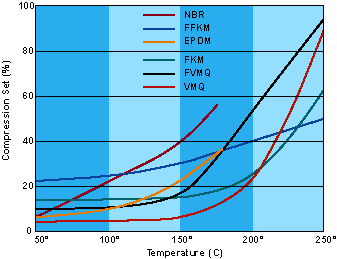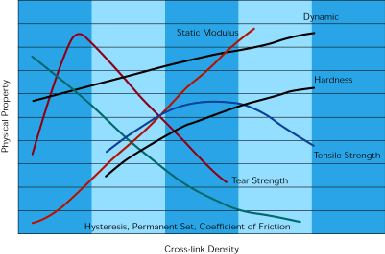| Hardness
The hardness of an elastomer is measured based on the depth of
indentation by a standard size and shape impacting gauge. The
hardness is obtained by comparing the difference between a small
initial force and a much larger final force. The International Rubber
Hardness Degrees (IRHD) scale has a range of 0 to 100, corresponding
to elastic modulus of 0 (0) and infinite (100), respectively. The mea-surement
is made by indenting a rigid ball into the rubber specimen.
The Shore A scale is the most prevalent in the United States.
A ¤frustoconicalË indentor with a spring force that decreases with
increasing indentation is used. The readings range from 30 to 95
points. Harder materials use a pointed conical indentor with the
Shore D scale. The results of the Shore A
scale and the IRHD scale are approximately
equal over the same range of resiliency.
In compounds with unusually high rates
of stress relaxation or deformation
hysteresis, the difference in dwell time
in the two readings may cause different
results. Also, the results of any hardness
test depend on the elastomer thickness.
Specified thickness should be used when
conducting these tests.
Due to the mechanical limits of the test
instruments, hardness measurements
are rarely expressed more precisely than
5 points.
Tensile Strength vs. Hardness

The surface indentation or hardness
usually does not bear any relation to the
ability of an elastomeric part to function
properly. Hardness is a measure of a
material╠s response to a small surface
stress. Stiffness and compressive modulus
measure the response to large stresses of
the entire elastomeric part.
Test Methods: ISO 48 (IRHD), ISO 7619 (Shore A), ASTM
D1415 (IRHD), D2240 (Shore)
Hardness vs. Temperature

Hardness (IRHD) vs. Young's Modulus (M)

Tensile Stress-strain
Tensile strength is the maximum tensile
stress reached in stretching a test piece
(either an O-ring or dumbbell).
Elongation: The strain, or ultimate elongation, is the amount of
stretch at the moment of break.
Modulus: Also called ¤Mod 100,Ë this is the stress required to
produce a given elongation. In the case of ¤Mod 100,Ë the modulus
would be the stress required to elongate
the sample 100%. In elastomers, the
stress is not linear with strain.
Therefore the modulus is neither a ratio
nor a constant slope█but rather denotes
a point on the stress-strain curve.
Tensile tests are used for controlling
product quality and for determining the
effect of chemical or thermal exposure
or an elastomer. In the latter case, it
is the retention of these physical
properties, rather than the absolute
values of the tensile stress, elongation
or modulus, that is significant.
Test Methods: ISO 37, ASTM D412
Stress vs. Strain

Bulk Modulus/Resiliency
Elastomers are often treated as incompressible materials for
analytical convience. However, in many instances the compressive
response of elastomers is very important.
Bulk or Static Modulus. The bulk modulus is a property of a
material which defines its resistance to volume change when
compressed. It can be expressed as:
K =
p/ev
Here p is the hydrostatic pressure, ev is the volumetric strain and K
is the bulk modulus. In practice, a positive volumetric strain is
defined as a decrease in volume.
Measuring a material╠s strain response to an applied pressure is a
simple test for bulk modulus. The bulk modulus can be expressed
as the derivative (slope) of the pressure-strain curve.
Relationships between Young╠s modulus E, the shear modulus G,
and Poisson╠s ratio v are related by:
E = 3 K (1 Ď 2v)
E = 2 G (1 + v)
Test Methods: ISO 774, ASTM D575
Bulk Modulus Test Assembly
 Rebound
Resilience. When a pendulum
hammer impacts a rubber specimen from
a certain distance or angle, the degree or
distance that the pendulum does not
return is an indication of the energy lost
during the deformation. Rebound
Resilience. When a pendulum
hammer impacts a rubber specimen from
a certain distance or angle, the degree or
distance that the pendulum does not
return is an indication of the energy lost
during the deformation.
Test Methods: ISO 4662,
ASTM D1054, D2632
Compression Set/Creep
Compression set is a measurement of the ratio of elastic to viscous
components of an elastomer╠s response to a given deformation.
Longer polymer chains tend to give better ¤set resistanceË because
of the improved ability to store energy (elasticity).
Compression set measurement standards call for a 25% compression
for a given time and temperature. The cross-section is measured
after the load is removed. Compression set is the percentage of the
original compression (25%) that is not recovered. This test may be
conducted on cylindrical disks or O-rings. At the end of the test,
the samples are removed and allowed to cool at room temperature
for 30 minutes before measuring. After a load is released from an
elastomer, the difference between the final dimensions and the
original dimensions is considered the compression set.
Compression
Set Test Assembly
 The use of compression set measurements is most beneficial
for production quality control, indicating the degree of curing.
Elastomers with high compression set values may require special
considerations for gland design and
handling. Compression set is a relatively
simple test to perform, and as such,
may not yield the type of predictive
information desired for custom sealing
applications. The use of compression set measurements is most beneficial
for production quality control, indicating the degree of curing.
Elastomers with high compression set values may require special
considerations for gland design and
handling. Compression set is a relatively
simple test to perform, and as such,
may not yield the type of predictive
information desired for custom sealing
applications.

When a constant load is placed on
an elastomer, the deformation is not
constant, but rather it increases gradually
with time. Terms used to describe this
behavior are relaxation or creep. These
properties, including compression set,
are a result of physical (viscoelastic) and
chemical (molecular structure) changes
in an elastomer.
Test Methods:
ISO 815 (Ambient & High Temp.)
ISO 1653 (Low Temp.)
ASTM D395 (Ambient & High Temp.)
D1229 (Low Temp.)
Retained
Sealing Force Test Assembly

Stress Relaxation/Retained
Sealing Force
Elastomers are viscoelastic in nature.
When deformed, energy storage is always
accompanied by some energy dissipation.
The entanglements of the long elastomer
chains act as obstructions to the movement of the polymer chains.
These obstructions enable the elastomer to store energy█an elastic
property. The rearrangements of the polymer chains are dependent
on the specific chemical structure, time, temperature and deformation
rate. Since elastomers are viscoelastic, the stored energy decreases
over time. This decrease of the stored energy (seen as contact
sealing force) over time is known as stress relaxation. In other
words, stress relaxation is the change in stress with time when
the elastomer is held under constant strain.
Common instruments for measuring stress relaxation are Lucas and
Wykeham Farrance. There are three standard methods:
Method A█compression is applied at test temperature and all
force measurements are made at test temperature.
Method
B█compression and force measurements are made at
ambient temperature.
Method C█compression is applied at ambient temperature and
all force measurements are made at test temperature.
The three methods do not give the same values of stress
relaxation. The resulting force measurements in all methods
can be normalized to the initial counterforce, and expressed as
a Retained Sealing Force percent.
Test Methods:
ISO 8013█Creep Strain Relaxation
ASTM
D412█Creep Strain Relaxation█Tensile Properties
ISO 3384█Stress
Relaxation
Sealing
Force Retention

Shear Modulus/Tear Strength/Dynamic Stress-Strain
Shear Modulus: The shear modulus is an important property in
design calculations for elastomers used in shear. The test methods
typically require that the test sample be bonded to metal plates.
The resulting ratio of the shear stress to shear strain is the shear
modulus.
Test Methods:
ISO 1827
Tear Strength: For considerations of removing a molded part from
the production mold, or for determining the ease of which a tear
can start and propogate in application, tear strength is an important
property. Different test methods use different shapes and methods
for applying a tearing force.
Test Methods:
ISO 34, 816
ASTM D624
Dynamic Stress-Strain: In cyclic or dynamic applications, the
viscoelastic properties of elastomers are very important. Lost
energy, in the form of heat, arises from molecular friction as a
result of an applied load. The percentage
energy loss per cycle is known as
¤hysteresis.Ë When the loading and
unloading cycle continues, the shape and
position of the hysteresis curve changes.
The response of a specimen to a sinusoidal
deformation can best exhibit the dynamic
properties of an elastomer. The elastic
component of the elastomer is responsible
for the in-phase stress, while the viscous
component is responsible for the out-of-phase
stress. The amount by which the
strain response lags the resultant of the
two stresses (in-phase and out-of-phase) is
known as the phase or loss angle, ´. The
more viscous an elastomer, the greater the
phase or loss angle. The tangent of this
angle ¤tan ´,Ë in the simplest terms, is
the ratio of the viscous modulus to the
elastic modulus.
Dynamic
Properties for Various Sealing Elastomers
| PROPERTY |
AEGIS |
FLUORO
ELASTOMER |
EPDM |
NITRILE |
SILICONE |
FLUORO
SILICONE |
| Tensile
Strength |
GOOD |
EXCELLENT |
EXCELLENT |
EXCELLENT |
FAIR |
FAIR |
| Abrasion
Resistance |
FAIR |
GOOD |
GOOD |
GOOD |
POOR |
POOR |
| Tear
Resistance |
FAIR |
FAIR |
EXCELLENT |
EXCELLENT |
POOR |
POOR |
|  Rubber is composed of long chains of
randomly oriented molecules. These long
chains are subject to entanglement and
cross-linking. The entanglement has a
significant impact on the viscoelastic
properties such as stress relaxation. When
a rubber is exposed to stress or strain
energy, internal rearrangements such as
rotation and extension of the polymer
chains occur. These changes occur as a
function of the energy applied and the
duration and rate of application, as well
as the temperature at which the energy
is applied.
Rubber is composed of long chains of
randomly oriented molecules. These long
chains are subject to entanglement and
cross-linking. The entanglement has a
significant impact on the viscoelastic
properties such as stress relaxation. When
a rubber is exposed to stress or strain
energy, internal rearrangements such as
rotation and extension of the polymer
chains occur. These changes occur as a
function of the energy applied and the
duration and rate of application, as well
as the temperature at which the energy
is applied.





 Rebound
Resilience. When a pendulum
hammer impacts a rubber specimen from
a certain distance or angle, the degree or
distance that the pendulum does not
return is an indication of the energy lost
during the deformation.
Rebound
Resilience. When a pendulum
hammer impacts a rubber specimen from
a certain distance or angle, the degree or
distance that the pendulum does not
return is an indication of the energy lost
during the deformation.  The use of compression set measurements is most beneficial
for production quality control, indicating the degree of curing.
Elastomers with high compression set values may require special
considerations for gland design and
handling. Compression set is a relatively
simple test to perform, and as such,
may not yield the type of predictive
information desired for custom sealing
applications.
The use of compression set measurements is most beneficial
for production quality control, indicating the degree of curing.
Elastomers with high compression set values may require special
considerations for gland design and
handling. Compression set is a relatively
simple test to perform, and as such,
may not yield the type of predictive
information desired for custom sealing
applications.




